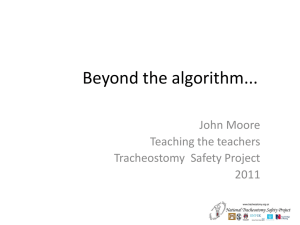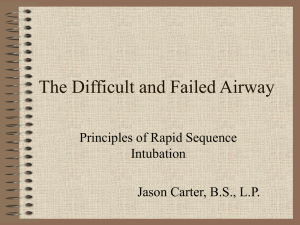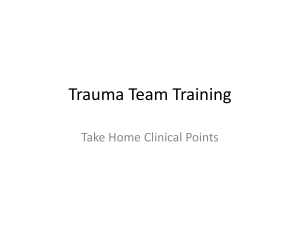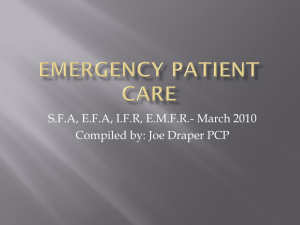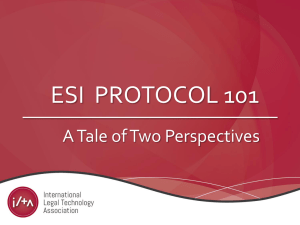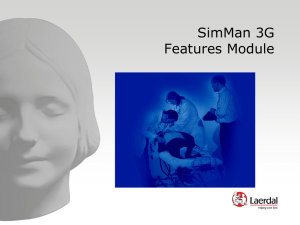esi triage - WordPress.com
advertisement
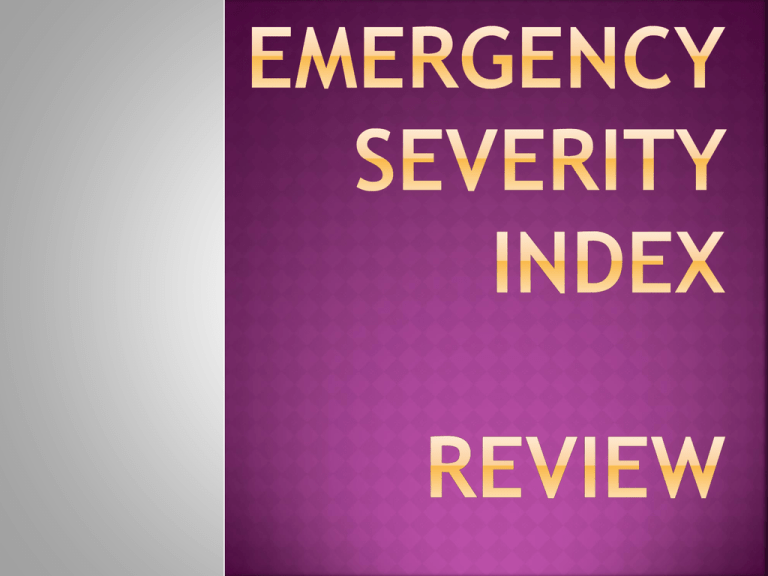
ESI Triage Algorithm Yes requires immediate life-saving intervention? 1 A No high risk situation? or confused/lethargic/disoriented? or severe pain/distress? Yes B How many different resources are needed? --------------------------------------------------------------------------------------none one many C 2 5 4 Danger zone vitals? Age HR RR < 3 mo > 180 > 50 3m-3y > 150 > 40 3y- 8y > 140 > 30 >8y > 100 > 20 Consider SaO2<92% D No 3 Does the patient require immediate life saving intervention? Airway Obstructed or partially obstructed Unable to protect their own airway Breathing Apneic Intubated prehospital Severe respiratory distress SpO2 less than 90% Cont. Circulation Pulseless or concerned about rate, rhythm or quality Drugs Hemodynamic interventions Immediate IV medications to correct hemodynamic instability Does this patient have an acute mental status change that requires immediate life saving intervention? Is Hypoglycemia needs glucose Heroin OD needs narcan Subarachnoid bleed needs airway protection this patient a P or U on the AVPU scale Cardiac or respiratory arrest Overdose with a RR of 8 Severe respiratory distress Acute SOA with SpO2 < 90% Anaphylactic shock Critically injured trauma patient Chest pain, pale, diaphoretic Chest palpitations, HR 180+ Unresponsive with strong odor of alcohol Severe stroke needs airway protection Airway and breathing Intubation Surgical airway CPAP, BiPAP Bag valve mask Defibrillation External pacing Chest needle decompression Hemodynamics Significant IV fluid resuscitation Blood administration IV medications Vasopressors Control of major bleeding Immediate Life-saving Interventions Life-saving Not life-saving Airway breathing BVM ventilation Intubation Surgical airway Emergent CPAP Emergency BiPAP Oxygen administration Nasal cannula Non-rebreather Electrical Therapy Defibrillation Emergent cardioversion External pacing Cardiac Monitor Procedures Chest needle decompression Pericardiocentesis Open thoracotomy Intraoseous access Diagnostic tests ECG Labs Ultrasound FAST (focused abdominal scan for trauma) Hemodynamics Significant IV fluid resuscitation Blood administration Control of major bleeding IV access Saline lock for medications Medications Naloxone D50 Dopamine Atropine Adenocard ASA IV nitroglycerin Antibiotics Heparin Pain medications Respiratory treatments with beta agonists Is this a high risk situation? Is this patient confused, lethargic or disoriented? Is this patient in severe pain or distress? The triage nurse obtains pertinent subjective and objective information to quickly answer these questions Decision Point B: Should the patient wait? High risk situation? or confused/lethargic/disoriented? or severe pain/distress? Yes B 2 Determination is based on a brief patient interview, gross observations, “sixth sense” Do not require a full set of vital signs Unsafe for the patient to wait Suggestive of a condition that could easily deteriorate Symptoms of a condition that’s treatment is time sensitive Potential for major life or organ threat Episodes of chest pain, denies other symptoms, known cardiac history R/O PE Newborn with a fever Rule out ectopic pregnancy Neutropenia with a fever Suicidal/homicidal Is there an acute change in level of consciousness? Is this situation where the brain is structurally or chemically compromised? New onset of confusion in an elderly patient 30 y.o. with a known brain tumor whose wife reports that he is confused Adolescent found confused and disoriented Is the patient currently in Pain? Pain intensity rating Chief complaint PMH, medications VS, physical assessment findings Assign ESI level 2 if and only if: Self reported 7/10 or greater AND RN cannot intervene AND they require immediate intervention Does this patient need your last bed? ? Kidney stone Severe flank pain, vomiting Burn victim Burns to both arms Oncology patient Possible dislocated shoulder ? Rates pain 10+, diaphoretic, tearful Compartment syndrome Sexual assault victim Combative patient Homicidal/suicidal patient Bipolar patient who is manic Acute grief reaction Known alcohol use with head injury How many resources None One 2 or more 5 4 3 Determined by the experienced ED RN at triage Based on the standard of care Independent of type of hospital, location, physician on duty, acuity of the department Resources: Labs ECG X-ray CT, MRI IV fluids IV, IM meds & nebs Specialty Consult Simple procedure=1 (lac repair, foley cath) Complex procedure=2 (conscious sedation) Not Resources: History and Physical Pelvic Point of care testing Saline or heplock PO medications Tetanus shot Prescription refills Phone call to PCP Simple wound care Crutches, gel splints, slings No Resources Examples -Healthy 10y.o. with “poison ivy” -Healthy 52y.o. Who ran out of his BP med recently -22y.o. involved in an MVC 2 days ago, just wants to get checked -46y.o. with a cold Stable, can safely wait for hours to be seen Care by mid-level providers in a fast track or urgent care setting Requires a physical exam and one resource Examples: -Healthy 19y.o. with a sore throat and fever -Healthy 29y.o. with a UTI, denies abdominal pain -Healthy 43y.o. with a stubbed toe -Healthy 12y.o. with a minor thumb laceration 30-40% of patients seen in the ED Need 2 or more resources Require in-depth evaluation Long length of stay Before assigning a patient to ESI level 3 the nurse must consider the patients vital signs ESI Fractured ankle Abdominal pain Most migraines ESI level 4 Sprained ankle Abscess ESI level 3 level 5 Toothache
